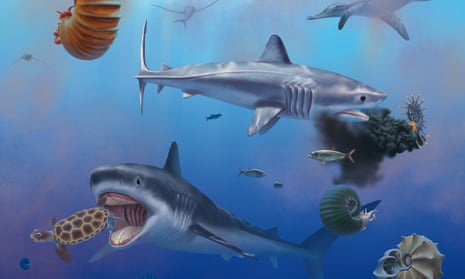Fossil experts say they have gained unprecedented insights into a type of enormous prehistoric shark, after finding complete skeletons of the creatures.
The specimens, discovered in small quarries in north-eastern Mexico within the last decade, belong to Ptychodus – a creature that roamed the seas from around 105m to 75m years ago.
Ptychodus fossils had turned up before but with its bones made of cartilage, which does not mineralise well, many were isolated teeth, which were huge and unusual.
As a result, it was difficult to pin down exactly what Ptychodus looked like and where it sat on the evolutionary family tree.
“Its general appearance has remained a mystery up to now because of the lack of more complete material during almost two centuries,” said Dr Romain Vullo, first author of the research from the University of Rennes.
“The discovery of the new specimens from Vallecillo, revealing the body shape and anatomy of this extinct shark, solves this enigma.”
Prof Michael I Coates of the University of Chicago, who was not involved in the work, said the new fossils were superb.
“Ptychodus has long been a classic example of teeth in search of a body,” he said. “And here we have it, with thorough analyses of where it sits in the shark family tree and a good stab at its ecomorphology – how it fits into marine ecosystems of the late Cretaceous.”
Writing in the journal Proceedings of the Royal Society B, Vullo and colleagues report how they studied six Ptychodus specimens, dating from about 93m years ago.
Among them was a complete specimen revealing a side view of Ptychodus, containing not only almost all its skeletal elements but also teeth, preserved muscle remains and a body outline complete with all its fins.

A further three of the specimens were almost complete, including a juvenile measuring just over 56cm in length, while the remaining two specimens were incomplete or partial skeletons.
The team say the plethora of features preserved within the specimens, including its fin skeletal anatomy, enabled them to carry out a fresh analysis of where Ptychodus sits on the evolutionary family tree.
The results reveal it was a kind of mackerel shark – a group that includes the extinct gigantic shark megalodon and the great white shark that inhabits oceans today.
The researchers add that as well as its overall body shape and proportions, a number of features of Ptychodus, including the size, shape and position of its fins, as well as its thick vertebral column, suggest it was fast-swimming, while its massive pavement-like teeth support previous conclusions it fed on shelled creatures.
Taken together, the team say the findings suggest Ptychodus hunted prey in open water, with its meals probably comprising sea turtles and ammonites rather than creatures such as clams that dwelled on the sea floor, as had previously been thought.
“Ptychodus was generally thought to be morphologically similar to benthic sharks like the modern nurse shark, but we now know that it looked like the extant porbeagle shark, a fast-swimming pelagic form,” said Vullo.
While Ptychodus was possibly the largest shark ever to live on such a diet, the new fossils suggest it had a maximum length of about 9.7 metres – larger than today’s great white shark but smaller than previous estimates that suggested it could have reached more than 10 metres in length.
The study also offers hints as to the demise of Ptychodus, suggesting it could have died out because of competition with other creatures, such as large aquatic reptiles, that fed on similar prey.
Patrick L Jambura, an expert in fossil fish at the University of Vienna, who was not involved in the study but works alongside three of the authors, said this was important, given more than a third of all sharks and rays today were threatened with extinction.
“Ptychodus provides us with a mirror that shows us what will happen to large apex predators such as the white shark if we, as their main competitor, do not rethink our actions,” he said.
